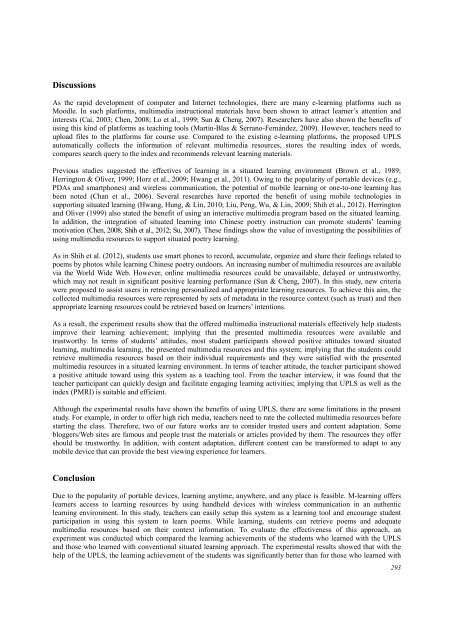Download Complete Issue in PDF - Educational Technology & Society
Download Complete Issue in PDF - Educational Technology & Society
Download Complete Issue in PDF - Educational Technology & Society
Create successful ePaper yourself
Turn your PDF publications into a flip-book with our unique Google optimized e-Paper software.
Discussions<br />
As the rapid development of computer and Internet technologies, there are many e-learn<strong>in</strong>g platforms such as<br />
Moodle. In such platforms, multimedia <strong>in</strong>structional materials have been shown to attract learner’s attention and<br />
<strong>in</strong>terests (Cai, 2003; Chen, 2008; Lo et al., 1999; Sun & Cheng, 2007). Researchers have also shown the benefits of<br />
us<strong>in</strong>g this k<strong>in</strong>d of platforms as teach<strong>in</strong>g tools (Martín-Blas & Serrano-Fernández, 2009). However, teachers need to<br />
upload files to the platforms for course use. Compared to the exist<strong>in</strong>g e-learn<strong>in</strong>g platforms, the proposed UPLS<br />
automatically collects the <strong>in</strong>formation of relevant multimedia resources, stores the result<strong>in</strong>g <strong>in</strong>dex of words,<br />
compares search query to the <strong>in</strong>dex and recommends relevant learn<strong>in</strong>g materials.<br />
Previous studies suggested the effectives of learn<strong>in</strong>g <strong>in</strong> a situated learn<strong>in</strong>g environment (Brown et al., 1989;<br />
Herr<strong>in</strong>gton & Oliver, 1999; Horz et al., 2009; Hwang et al., 2011). Ow<strong>in</strong>g to the popularity of portable devices (e.g.,<br />
PDAs and smartphones) and wireless communication, the potential of mobile learn<strong>in</strong>g or one-to-one learn<strong>in</strong>g has<br />
been noted (Chan et al., 2006). Several researches have reported the benefit of us<strong>in</strong>g mobile technologies <strong>in</strong><br />
support<strong>in</strong>g situated learn<strong>in</strong>g (Hwang, Hung, & L<strong>in</strong>, 2010; Liu, Peng, Wu, & L<strong>in</strong>, 2009; Shih et al., 2012). Herr<strong>in</strong>gton<br />
and Oliver (1999) also stated the benefit of us<strong>in</strong>g an <strong>in</strong>teractive multimedia program based on the situated learn<strong>in</strong>g.<br />
In addition, the <strong>in</strong>tegration of situated learn<strong>in</strong>g <strong>in</strong>to Ch<strong>in</strong>ese poetry <strong>in</strong>struction can promote students’ learn<strong>in</strong>g<br />
motivation (Chen, 2008; Shih et al., 2012; Su, 2007). These f<strong>in</strong>d<strong>in</strong>gs show the value of <strong>in</strong>vestigat<strong>in</strong>g the possibilities of<br />
us<strong>in</strong>g multimedia resources to support situated poetry learn<strong>in</strong>g.<br />
As <strong>in</strong> Shih et al. (2012), students use smart phones to record, accumulate, organize and share their feel<strong>in</strong>gs related to<br />
poems by photos while learn<strong>in</strong>g Ch<strong>in</strong>ese poetry outdoors. An <strong>in</strong>creas<strong>in</strong>g number of multimedia resources are available<br />
via the World Wide Web. However, onl<strong>in</strong>e multimedia resources could be unavailable, delayed or untrustworthy,<br />
which may not result <strong>in</strong> significant positive learn<strong>in</strong>g performance (Sun & Cheng, 2007). In this study, new criteria<br />
were proposed to assist users <strong>in</strong> retriev<strong>in</strong>g personalized and appropriate learn<strong>in</strong>g resources. To achieve this aim, the<br />
collected multimedia resources were represented by sets of metadata <strong>in</strong> the resource context (such as trust) and then<br />
appropriate learn<strong>in</strong>g resources could be retrieved based on learners’ <strong>in</strong>tentions.<br />
As a result, the experiment results show that the offered multimedia <strong>in</strong>structional materials effectively help students<br />
improve their learn<strong>in</strong>g achievement; imply<strong>in</strong>g that the presented multimedia resources were available and<br />
trustworthy. In terms of students’ attitudes, most student participants showed positive attitudes toward situated<br />
learn<strong>in</strong>g, multimedia learn<strong>in</strong>g, the presented multimedia resources and this system; imply<strong>in</strong>g that the students could<br />
retrieve multimedia resources based on their <strong>in</strong>dividual requirements and they were satisfied with the presented<br />
multimedia resources <strong>in</strong> a situated learn<strong>in</strong>g environment. In terms of teacher attitude, the teacher participant showed<br />
a positive attitude toward us<strong>in</strong>g this system as a teach<strong>in</strong>g tool. From the teacher <strong>in</strong>terview, it was found that the<br />
teacher participant can quickly design and facilitate engag<strong>in</strong>g learn<strong>in</strong>g activities; imply<strong>in</strong>g that UPLS as well as the<br />
<strong>in</strong>dex (PMRI) is suitable and efficient.<br />
Although the experimental results have shown the benefits of us<strong>in</strong>g UPLS, there are some limitations <strong>in</strong> the present<br />
study. For example, <strong>in</strong> order to offer high rich media, teachers need to rate the collected multimedia resources before<br />
start<strong>in</strong>g the class. Therefore, two of our future works are to consider trusted users and content adaptation. Some<br />
bloggers/Web sites are famous and people trust the materials or articles provided by them. The resources they offer<br />
should be trustworthy. In addition, with content adaptation, different content can be transformed to adapt to any<br />
mobile device that can provide the best view<strong>in</strong>g experience for learners.<br />
Conclusion<br />
Due to the popularity of portable devices, learn<strong>in</strong>g anytime, anywhere, and any place is feasible. M-learn<strong>in</strong>g offers<br />
learners access to learn<strong>in</strong>g resources by us<strong>in</strong>g handheld devices with wireless communication <strong>in</strong> an authentic<br />
learn<strong>in</strong>g environment. In this study, teachers can easily setup this system as a learn<strong>in</strong>g tool and encourage student<br />
participation <strong>in</strong> us<strong>in</strong>g this system to learn poems. While learn<strong>in</strong>g, students can retrieve poems and adequate<br />
multimedia resources based on their context <strong>in</strong>formation. To evaluate the effectiveness of this approach, an<br />
experiment was conducted which compared the learn<strong>in</strong>g achievements of the students who learned with the UPLS<br />
and those who learned with conventional situated learn<strong>in</strong>g approach. The experimental results showed that with the<br />
help of the UPLS, the learn<strong>in</strong>g achievement of the students was significantly better than for those who learned with<br />
293

















